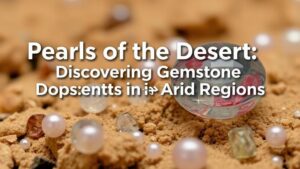The Glow of Peridot: Discovering Gems in Volcanic Fields
The Glow of Peridot: Discovering Gems in Volcanic Fields
For rockhounds and mineral collectors, the thrill of discovering gemstones in their natural settings is an unparalleled experience. One such gem, peridot, is renowned for its vibrant green color and is a fascinating byproduct of volcanic activity. This article delves into the origins, characteristics, and practical tips for collectors seeking the rare glow of peridot in volcanic fields.
Understanding Peridot
Peridot is a gem-quality variety of the mineral olivine, primarily composed of magnesium iron silicate. It is unique among gemstones because it forms deep within the Earth’s mantle and is brought to the surface through volcanic eruptions. Peridot crystallizes at extreme temperatures, typically between 1,500 to 2,000 degrees Celsius (2,732 to 3,632 degrees Fahrenheit), making it one of the few gems found in lava flows.
Sources and Geological Context
The most significant sources of peridot are found in volcanic regions, particularly in places like Hawaii, where the gemstone has a strong connection to the islands volcanic activity. Other notable locations include:
- Island of Samoan, where peridot emerges from olivine-rich lavas.
- Apache Junction in Arizona, known for its gem-quality deposits.
- Pakistans Kunar Province, sources of high-quality peridot crystals.
The geological context of peridot offerings is critical in understanding where to find this remarkable gem. Volcanic fields not only boast the right conditions for peridot formation but also provide insight into the composition of the Earth’s interior.
Identifying Quality Peridot
When searching for peridot, collectors should pay attention to specific characteristics. High-quality peridot can range from olive green to a vibrant lime color, with a strong saturation and clarity. Notable features include:
- Color: Ideal peridot displays a rich green hue, often compared to the olive leaves.
- Clarity: Look for stones free of visible inclusions that might detract from their beauty.
- Cut: Well-cut peridot will reflect light beautifully, enhancing its glow.
Collecting Tips and Best Practices
For rockhounds eager to find their own peridot specimens, following best practices will ensure a successful collecting trip:
- Research Local Laws: Always check regulations regarding mineral collection, as restrictions may vary significantly between locations.
- Explore After Rainfalls: Wet conditions can wash away debris, exposing new gems and minerals to discover.
- Sift Through Lava Fields: Look for areas where lava has cooled and cracked; these spots often host deposits of peridot.
Also, carrying tools such as a sturdy rock hammer, chisel, and safety goggles can enhance your collecting experience and ensure safety around volcanic environments.
Real-World Applications of Peridot
Beyond its allure as a gemstone, peridot has practical applications in various industries. For example, olivine, the mineral that is the precursor to peridot, is utilized in:
- Green Technology: Peridot’s function as a magnesium-rich material makes it valuable in promoting carbon capture.
- Cement Production: The mineral’s properties assist in the creation of eco-friendly construction materials.
Recognizing the broader implications of peridot can provide collectors with a nuanced appreciation for their finds beyond aesthetic value.
Conclusion: The Journey of Discovery
Collecting peridot in volcanic fields is not only an adventure but also an opportunity to connect with the Earths geological history. This vibrant gemstone showcases the beauty and complexity of nature’s processes. Armed with knowledge and practical tips, rockhounds can embark on their quests, potentially uncovering treasures that encapsulate both the glow of the gemstone and the fiery beauty of volcanic landscapes.
Whether you are a seasoned collector or just beginning your journey, the world of peridot awaits, glowing with opportunities for exploration and discovery.



